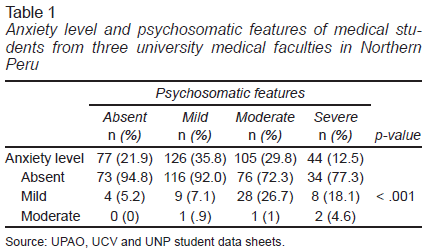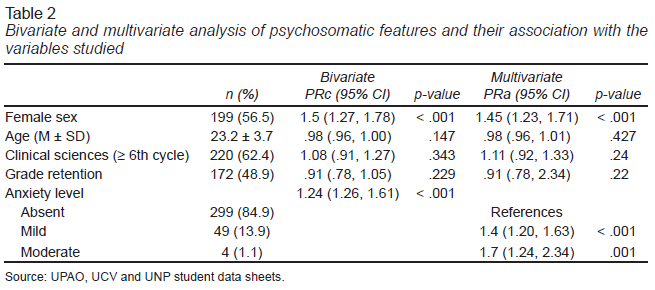INTRODUCTION
The current global prevalence estimate for anxiety is 26.9% (Nochaiwong et al., 2021). Anxiety is a response of the autonomic nervous system consisting of defensive reactions to danger, which perform a protective function and are considered to be the basis of learning and motivation. If it happens repeatedly, prolonged manner, it disrupts physiological and psychosocial functioning (Galiano-Ramírez, Castellanos-Luna, & Moreno-Mora, 2016). Compounded by the context of the COVID-19 pandemic and the new normality, it leads to psychosomatic disorders (Bartmann et al., 2021; Tollos, Theodorakopoulou, & Christodoulou, 2021).
A psychosomatic disorder is a condition in which psychological stresses negatively affect a person’s physiological (somatic) functioning. Psychosomatic symptoms therefore arise as a physiological concomitant of an emotional state (Sajid, Ahmad, & Khalid, 2015). In this case, psychosomatic symptoms, resulting from stress and anxiety, are part of a physical ailment and their emergence can be linked to the setting and time in which they occur (Trebin, 2020).
University students often report anxiety and stress together with psychosomatic symptoms. It has been documented that they may have similar levels to those of other populations, such as the chronically ill. University students are considered to be a particularly vulnerable population, which is exposed to stressors and their effects (Maria-Jereyard & Bhuvaneswari, 2019).
Medical students are not exempt from this, undergoing adaptive physiological, neuroendocrine, immunological, emotional, and behavioral processes during their university education (Atta & Almilaibary, 2022; Salam et al., 2015). They experience multiple academic and social activities that create enormous anxiety and stress, affecting optimal learning and academic performance (Alzahrani, Alghamdi, Alqarni, Alshareef, & Alzahrani, 2019; Cabanach, Souto-Gestal, & Fernández Cervantes, 2017).
The academic factors associated with the development of anxiety and depression are grade retention, age, and sex (de La Rosa-Rojas et al., 2015; Quito-Calle, Tamayo-Piedra, Buñay-Barahona, & Neira-Cardenas, 2017). Anxiety and depression increase in intensity according to the year of study, with higher levels of anxiety occurring during clinical science semesters (Anton et al., 2021).
It is important to evaluate mental health in medical students, specifically during the pandemic. As a result of the factors mentioned earlier, the aim was to determine the association between anxiety levels and the degree of psychosomatic features in medical students.
METHOD
Study design
A cross-sectional, analytical study was undertaken with convenience sampling.
Subjects/sample description
The study was conducted in the city of Piura in Northern Peru. Three hundred and fifty-two medical students from Antenor Orrego Private University (UPAO), César Vallejo University (UCV) and the National University of Piura (UNP) were enrolled in the study. The UPAO and UCV are private universities, whereas the UNP is a state university. University students enrolled in the 2022-I semester were included. Study participants were youths aged seventeen and older. Those with psychiatric diagnoses prior to their admission to university were excluded.
Measurements
A survey was designed in Google Forms with the instruments used, comprising three sections. The first records general characteristics (age, sex, semester, and grade retention); the second psychosomatic features and the third the degree of anxiety. To assess psychosomatic features, the 15-item PHQ-15 (Patient Health Questionnaire Physical Symptoms) was used, with scores ranging from 0 to 30 and scores ≥ 5, ≥ 10, and ≥ 15 representing mild, moderate, and severe levels of somatization (Kroenke, Spitzer, & Williams, 2002). This scale was previously used in a national study on adolescents in metropolitan Lima in 2018 (Bulnes-Bedón, Alvarez-Taco, & Morales-Isasi, 2018). The degree of anxiety was evaluated using Zung’s 20-item Self-rating Anxiety Scale (Dunstan & Scott, 2020). In its Spanish version, each item was evaluated on a Likert scale, rated from 1 to 4, with the lowest score being 20 and the highest 80. Scores 50-59, 60-69, and 70 and over represent mild, moderate, and severe anxiety, respectively.
Procedure
Once permission had been granted by the universities and the study had been approved by the ethics committee of Antenor Orrego Private University, data were collected in March and April of 2022. To corroborate their status as registered students, standardized messages were sent with an invitation to participate in the study to the institutional emails of medical students from UPAO, UCV, and UNP universities. If the students agreed to participate, they were contacted via WhatsApp on their personal cell phones to explain the objective of the study, the selection criteria, the informed consent form and the way the measurement tool should be completed. Students who met the selection criteria and voluntarily agreed to participate were sent the online link to Google Forms.
Statistical analysis
Data from the surveys undertaken were entered into a Microsoft Excel spreadsheet for cleaning and purging. STATA version 16 was used for the analysis. The PHQ-15 screening instrument and Zung’s test scores were categorized and regarded as qualitative variables, which were presented in frequency and percentage. The quantitative variable age was presented as a mean and standard deviation. The chi-square test was used to find an association. The PRc and PRa were subsequently calculated (adjusting for age, gender, study cycle and grade retention).
Ethical considerations
There were no risks or benefits for any participant. Answering the virtual survey did not involve any expense, nor were financial incentives provided. Data confidentiality was maintained, and participant anonymity respected. The project was approved by the ethics committee of Antenor Orrego Private University with code RR Nº 3335-2016-R-UPAO.
RESULTS
Association between anxiety and psychosomatic features
As can be seen from Table 1, the degrees of PF were categorized, determining the level of anxiety for each degree. It was found that over 75% of the students surveyed presented PF. The maximum level of anxiety found was moderate, with a progressive increase being observed in cases with the most severe degrees of PF. The association was highly significant.
Factors associated with psychosomatic features
Table 2 shows that being female increases the risk of presenting psychosomatic features by 45% compared to males. Presenting a mild and moderate level of anxiety increases the risk of PF by 40% and 70% respectively. There were no significant associations with age, studying clinical sciences or grade retention.
DISCUSSION AND CONCLUSION
This study, which was designed to determine the association between psychosomatic features and anxiety levels in university students, included a total of 352 students.
It was found that 35.8% presented mild, 29.8% moderate, and 12.5% severe psychosomatic features, with a total of 78.1% presenting some type of psychosomatic feature. Despite these figures, there is a dearth of information in the recent literature on the prevalence of psychosomatic features in university students. However, this is associated with the high prevalence of psychosomatic features in health workers, which is above 75% (López-Rodríguez, García-Gracia, Ponce-Martín, Arranz-Ballesteros, & Parejo-Aguilera, 2021; Uribe-Prado, 2020).
The degree of anxiety found was distributed as follows: 13.9% presented a mild degree of anxiety and 1.1% a moderate degree. The degree of anxiety found was distributed as follows: 13.9% showed a mild and 1.1% a moderate degree. These results vary according to the type of test used to determine the degree of anxiety. Thus, for example, a study conducted by Ordóñez-Galeano (2020) in Guatemala using Beck’s inventory with first and last year medical students found that 68% and 66% experienced mild anxiety, and 41% and 57% moderate anxiety respectively (Ordóñez-Galeano, 2020). At the international level, in Spain, Gutiérrez-Pastor I. used Goldberg’s Anxiety and Depression Scale (GADS) for medical students at a Spanish university, finding a global anxiety rate of 54.9% (Gutiérrez-Pastor, Quesada-Rico, Gutiérrez-Pastor, Nouni-García, and Carratalá-Munuera, 2021). Peruvian studies have revealed a high incidence of anxiety, ranging from 23% according to the Beck Inventory to 75.4% using the Generalized Anxiety Disorder Assessment (GAD-7; Armas-Elguera, Talavera, Cárdenas, & de la Cruz-Vargas, 2021; Saravia-Bartra, Cazorla-Saravia, & Cedillo-Ramirez, 2020). These values can be influenced by social and political settings such as the COVID-19 Pandemic (Saravia-Bartra et al., 2020) as well as by the year of study and the consumption of harmful products such as alcohol and tobacco (Robles-Mariños, Angeles, & Alvarado, 2022).
Our study found a low probability of the association between the degree of anxiety and psychosomatic features being due to chance (p < .001). It also discovered that the presence of any degree of anxiety increased by 40% (PRc = 1.4, 95% CI [1.26, 1.61], p value ≤ .001) the possibility of presenting psychosomatic features compared to students who had no anxiety. In the statistical analysis adjusted by age, gender, year of study and grade retention, it was found that female students were 45% were more likely (RPa = 1.45, CI 95% [1.23, 1.73], p value ≤ .001) to present psychosomatic features than male students In addition, having a mild or moderate level of anxiety meant that students were 40% (PRa = 1.4, 95% CI [1.20, 1.63], p value = ≤ .001) and 70% (PRa = 1.7, 95% CI [1.24, 2.34]. p value = .001) more likely to present psychosomatic features respectively, compared with those who do not experience anxiety. This can be explained by the nature of these somatic symptoms, which are often considered to be vague somatoform disorders superimposed on depression or anxiety or organic causal attributions. This means that the presence of a mental condition is necessary for the presence of a psychosomatic symptom (Trebin, 2020). These stressors produce selective alterations of large-scale brain networks involved in cognitive control and the regulation, and processing of emotions, stress, and somatic-visceral perception, leading to various psychosomatic features such as headaches, low back pain, joint pain, retro-ocular pain, nausea, dizziness, vomiting, seizures (conversion syndrome), and fainting (Rossetti et al., 2021).
The study concludes that psychosomatic features are found in approximately 75% of medical students and anxiety in approximately 15%. Mild and moderate anxiety is an influential factor in psychosomatic features, as is being female. Given this situation, periodic evaluations and anxiety management sessions could be proposed to reduce psychosomatic features to ensure the mental health of future doctors, which will have a positive effect on their academic training.

